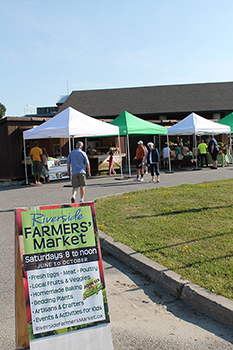
![]()
U of G research has revealed some of the reasons new veterinary graduates are not dedicating their futures to attending to food animals, like beef and dairy cows, in some areas of rural Ontario, particularly northern Ontario. This research is now informing solutions to improve veterinary access for Ontario’s livestock farmers, grow the economy and deliver home-grown food to Ontarians.
Looking to understand barriers to attracting veterinarians to these underserved regions and their resultant impact on farmers, the researchers spoke to current veterinary students, producers, veterinarians, industry organizations and government staff.
Four years later, the research project has yielded evidence-based program, policy and practice updates designed to help support Ontario’s livestock producers and attract new veterinary graduates to underserved regions, particularly in northern Ontario.
This research was made possible by the Ontario Agri-Food Innovation Alliance, a collaboration between the Government of Ontario and U of G.
Understanding veterinary shortages in remote rural communities

The project was begun in 2020 by Dr. Sara Epp [1], professor in the Ontario Agricultural College’s School of Environmental Design and Rural Development [2]; Dr. David Kelton [3], now professor emeritus in the Ontario Veterinary College [4] (OVC); Dr. Stephen Roche [5], adjunct professor at OVC and director and principal consultant with ACER consulting [6]; and four graduate students.
“The study reaffirmed and documented many of the things we already suspected,” says Kelton. “Producers commonly expressed difficulty and frustration with accessing all manner of veterinary services in a timely manner, but especially emergency services.”
Some farmers said they have had to sign forms from their veterinarian acknowledging they won’t get prompt emergency care.
Veterinarians serving some remote communities face time-consuming and expensive drives from one farm to another.
Practitioners care deeply about animal welfare, says Epp, but having a balanced lifestyle is difficult if they’re driving 500 kilometres a day.
Many veterinarians are nearing retirement and are anxious about who will provide care afterward.
 Beef farmers in parts of northern and rural Ontario struggle to access timely veterinary care for their animals. Photo courtesy of Sara Epp.
Beef farmers in parts of northern and rural Ontario struggle to access timely veterinary care for their animals. Photo courtesy of Sara Epp.
An obvious solution is to encourage more early-career veterinarians to practise in underserved rural Ontario communities.
But the research team discovered barriers to rural community practice.
Some hurdles are financial, including the costs of externships and living in northern Ontario. Veterinarians may have less earning potential than in a companion animal practice.
Other barriers are social, including a lack of on-farm experience and confidence, and a limited awareness about where to go and types of work available.
These findings align with Epp’s previous research in northern Ontario, which found barriers often based on perception rather than experience.
“Finances are a huge motivator,” says Epp. She heard new graduates are recruited—with financial bonuses—from out of province.
As part of the research, M.Sc. student Minerva Cancilla-Styles worked on a jurisdictional scan and, with Roche, interviewed nearly two dozen stakeholders. “A lot of the producers expressed how, if the issues persist, they would not be able to continue operations,” says Cancilla-Styles. “As consumers, we should be concerned about the effect this would have on the agri-food system in Ontario.”

A sign for the Riverside Farmers’ Market
in New Liskeard advertises
fresh eggs, poultry and other local foods.
Photo courtesy of Sara Epp.
Proposing solutions
Solutions will be complex due to the issue’s multiple causes, says Roche. “There is no silver bullet. Graduating more vets won’t solve this problem, nor will just throwing money at it.”
The team proposed strategies from making academic program changes, to enabling municipalities to better support and attract veterinarians, to changing veterinary business models.
Possible enticements for current students to consider large animal practices are financial incentives such as debt forgiveness, grants, increased subsidies and scholarships; mentorship; and allotment of positions in OVC for Northern students.
Changes to veterinary programs could address barriers such as a lack of on-farm experience and insufficient knowledge about integrating into a rural community.
Municipalities could also play a role, as in physician recruitment, says Epp.
Research findings were provided to the Ontario Ministry of Agriculture, Food and Agribusiness (OMAFA) to support evidence-informed policy. The research team compiled simple toolkits for academia, government, veterinarians and rural municipalities. The toolkits, outlining roles and responsibilities, research results and recommendations, were shared with each group and are also available at SaraEpp.com [7].
 Toolkits for academia, government, veterinary organizations and northern municipalities are available on SaraEpp.com.
Toolkits for academia, government, veterinary organizations and northern municipalities are available on SaraEpp.com.
Making an impact: Informing evidence-based policy
“This study provided detailed insights on the challenges stakeholders are facing due to the shortage of veterinary professionals in the province,” says Bailey Kleefstra, policy adviser in the Sector Value Chain Policy Unit at OMAFA. “It also identified the causation for regional gaps and the complexity of this issue.
“This research is critical to enabling evidence-based policy decisions and generating new ideas, while supporting solutions that can focus on addressing existing barriers and areas of need.”
Since the results were shared with OMAFA, several changes have occurred in veterinary medicine and education in Ontario.
- A new Collaborative Doctor of Veterinary Medicine Program [8] brings together the University of Guelph’s OVC and Thunder Bay’s Lakehead University to enroll an additional 20 students per year, with an eye to rural, northern and Indigenous communities.
- The Veterinary Incentive Program [9] provides grants of up to $50,000 to care for large animals in underserved areas.
- Equipment grants for portable technologies, training and telemedicine are available via a $4-million Livestock Veterinary Innovation Initiative [10].
- U of G is teaming up with Northern College [11] to train registered veterinary technicians to support underserved communities.
- New annual scholarships from Beef Farmers of Ontario support OVC students who are interested in beef cattle and plan to provide veterinary care for food animals.
- The province identified increasing veterinary capacity as a key action in its Grow Ontario strategy [12].
There has been significant media interest in the project, with Epp sharing results with Real Agriculture [13] and SooToday.com [14].
“I think our work has been helpful in shining light on the multifactorial nature of this issue,” says Roche. “It has called out the gaps and key barriers and is being used to inform future discussions and initiatives across government and industry.”
